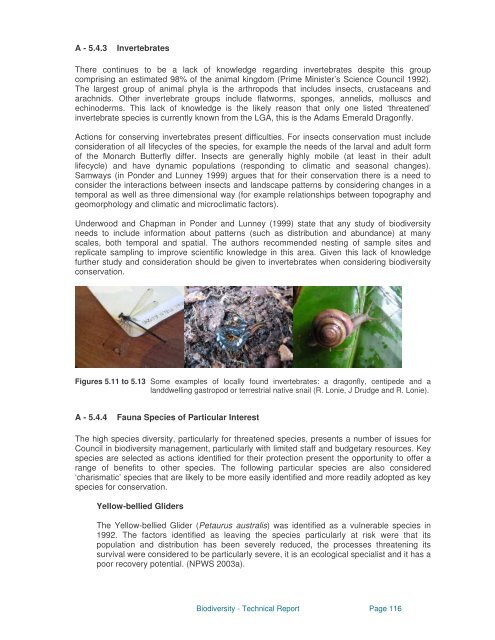Biodiversity Strategy - Gosford City Council - NSW Government
Biodiversity Strategy - Gosford City Council - NSW Government
Biodiversity Strategy - Gosford City Council - NSW Government
Create successful ePaper yourself
Turn your PDF publications into a flip-book with our unique Google optimized e-Paper software.
A - 5.4.3<br />
Invertebrates<br />
There continues to be a lack of knowledge regarding invertebrates despite this group<br />
comprising an estimated 98% of the animal kingdom (Prime Minister’s Science <strong>Council</strong> 1992).<br />
The largest group of animal phyla is the arthropods that includes insects, crustaceans and<br />
arachnids. Other invertebrate groups include flatworms, sponges, annelids, molluscs and<br />
echinoderms. This lack of knowledge is the likely reason that only one listed ‘threatened’<br />
invertebrate species is currently known from the LGA, this is the Adams Emerald Dragonfly.<br />
Actions for conserving invertebrates present difficulties. For insects conservation must include<br />
consideration of all lifecycles of the species, for example the needs of the larval and adult form<br />
of the Monarch Butterfly differ. Insects are generally highly mobile (at least in their adult<br />
lifecycle) and have dynamic populations (responding to climatic and seasonal changes).<br />
Samways (in Ponder and Lunney 1999) argues that for their conservation there is a need to<br />
consider the interactions between insects and landscape patterns by considering changes in a<br />
temporal as well as three dimensional way (for example relationships between topography and<br />
geomorphology and climatic and microclimatic factors).<br />
Underwood and Chapman in Ponder and Lunney (1999) state that any study of biodiversity<br />
needs to include information about patterns (such as distribution and abundance) at many<br />
scales, both temporal and spatial. The authors recommended nesting of sample sites and<br />
replicate sampling to improve scientific knowledge in this area. Given this lack of knowledge<br />
further study and consideration should be given to invertebrates when considering biodiversity<br />
conservation.<br />
Figures 5.11 to 5.13 Some examples of locally found invertebrates: a dragonfly, centipede and a<br />
landdwelling gastropod or terrestrial native snail (R. Lonie, J Drudge and R. Lonie).<br />
A - 5.4.4<br />
Fauna Species of Particular Interest<br />
The high species diversity, particularly for threatened species, presents a number of issues for<br />
<strong>Council</strong> in biodiversity management, particularly with limited staff and budgetary resources. Key<br />
species are selected as actions identified for their protection present the opportunity to offer a<br />
range of benefits to other species. The following particular species are also considered<br />
‘charismatic’ species that are likely to be more easily identified and more readily adopted as key<br />
species for conservation.<br />
Yellow-bellied Gliders<br />
The Yellow-bellied Glider (Petaurus australis) was identified as a vulnerable species in<br />
1992. The factors identified as leaving the species particularly at risk were that its<br />
population and distribution has been severely reduced, the processes threatening its<br />
survival were considered to be particularly severe, it is an ecological specialist and it has a<br />
poor recovery potential. (NPWS 2003a).<br />
<strong>Biodiversity</strong> - Technical Report Page 116
















